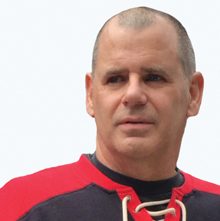The Inevitable Transition
When the physicality of the work takes its toll on your body, it’s time to start thinking about that next chapter in your career.

He’s played 1,114 games over the course of a 15-year career with the Chicago Blackhawks, averaging 21:56 minutes per game. He was an integral part of the three Stanley Cup-winning teams and has always been a leader, both on and off the ice. He’s been a player’s player and a coach’s dream.
His No. 7 jersey may never hang in the Hockey Hall of Fame, but it’s the only one I’ve bought in the last 20 years. I think that much of him. He just had shoulder surgery and is due to have both hips operated on this upcoming off-season. He’s been a healthy scratch five games this year, coach’s decision.
Brent Seabrook is now facing what all us who work in a physically demanding job face at some point or another — the fact that his body can’t take any more punishment. Not one more hit. Not one more blocked shot. Life comes at you fast, so you best be prepared for it.
When I was a kid, I’d run through a brick wall if that’s what my boss wanted me to do.
If he needed me to work 72 hours a week, I did. If you multiply $4.50/hour by 1.5, it equals $6.75/hour. Who in their right mind is going to walk away from that kind of rare coin?
Need me to cut and thread hundreds of feet of 2-inch black iron pipe by hand, hang it all from a 16-foot ceiling by myself? Consider it done.
Work a 14-hour day, spend the next 11 hours working all night because it’s winter in Chicago and people need heat, and then wrap it all up by working all day the following day? I’m your Huckleberry.
I lived that kind of insanity for the first five years of my career, working for others. And when I decided to go out on my own, things got really nuts.
I was no longer on on-call one week per month. I was on-call 24/7/365. Every day, every night, of every week and month, of every year for years and years. I had two very young daughters at the time, and I was missing more important events than any caring, loving dad should. And I was both. I wouldn’t even blink about working holidays. It was just another day to me.
I lived to work, and it took its toll. Don’t get me wrong. It’s the way I’m wired, and I enjoyed the madness in a demented sort of way. There’s a lot to be said for work ethic and taking pride in a job well done.
But when you’ve spent the better part of your life swinging steel pipe wrenches, moving cast-iron boiler sections up and down stairs, working in 125-degree attics and sloppy crawlspaces — and using your back, hips, shoulders, arms, wrists, legs and knees in ways they’re not meant to be used long term — body parts are going to rebel in a painful way that causes you to take notice.
I’ve had two neck surgeries, one back surgery, one hip surgery, three hand surgeries, a knee surgery, too many concussions to count and one shoulder surgery. Arthritis reigns supreme and breathing can be a chore now. I had no choice, but to put the tools down for good if I wanted any chance of seeing my granddaughters get married someday. And I do.
The benefit of knowledge and experience
I’ve since made the transition from boiler rooms to a desk and keyboard, and it’s been the biggest challenge of my career. I loved everything about being a boiler guy. I loved the Red Wing or Timberland boots I wore, the Lee Dungaree jeans that had a pocket for everything, taking a lunch to work, creating something from nothing every day, fixing things that most couldn’t, having the best tool collection around, my work truck and everything else.
Everything except the trouble of getting my body to move the last couple of years. It just didn’t want any part of it anymore, and I don’t blame it.
So here I am today, writing for PHC News and loving every minute of it. But that’s not all. I needed to stay in the game even more to be happy.
So, I hung up another shingle a few months ago: Minnich Hydronic Consulting & Design. It just made so much sense to me and I couldn’t deny the urge. I’ve been doing HVAC design work since 1987 when I did my very first Manual J heat loss/heat gain load calculation. I was 26 or 27 at the time and I always figured if somebody else could do something, I might be able to do it, too. So, why not try?
I did and I loved it. I also did my first duct design on that job with the help of someone with more experience than I had. And then, in the mid-1990s, I started designing all my hydronic jobs with a little help from my industry friends until they were needed less and less.
That’s my goal here. I want to help you. I want to help you plan and design your projects before any wrench gets lifted or any torch is sparked up. There’s nothing worse than sweating, pressing or wrenching pipes and fittings, setting boilers, wiring controls and sensors, and then finding out that it’s not working the way it’s supposed to work.
And you want to get paid, right? Well, your customer has a death grip on his checkbook and won’t open it until everything is jake. Let me help you avoid that mess.
Or maybe your time would be better spent addressing other needs of your business than designing systems?
I have 40 years of dedicated experience in the HVAC industry as an educator, inspector, technical support lead, industry columnist and award-winning contractor. Here’s a sample of what I can do for you:
Hot Water Boiler Systems Evaluation and Design
- Blueprint review.
- Evaluate condition of boiler.
- Near-boiler piping evaluation: pump location, expansion tank location, control strategy, air management and control, piping strategy, pipe sizes.
- Evaluate heat emitters: radiators, baseboard, fan coils, radiant panels.
- Perform Manual J heat loss load calculation based on information we gather on the building.
- Select new boiler based on Manual J load calculation and energy efficiency.
- Size system circulator(s) and boiler circulator(s) based on flow and head loss requirements.
- Determine near-boiler pipe sizes based on design delta T and flow requirements.
- Determine hydraulic separator size based on minimum flow rate requirements.
- Determine buffer tank size based on boiler turndown ratio and BTU requirement of smallest zone.
- Determine expansion tank size based on system water volume and BTU.
- Generate piping strategy and schematic.
- Generate control strategy and schematic.
- Determine outdoor reset curve based on system information and customer preferences.
- Generate material and equipment list if needed.
Radiant Panel System Design
- Perform Manual J heat loss load calculation.
- Determine BTU/square foot requirement to match heat loss.
- Determine floor surface temperature requirements.
- Choose projected installation method.
- Choose tube type and size based on installation method.
- Determine finished floor R-value.
- Determine tube spacing based on heat loss and application.
- Determine necessary supply water temperatures.
- Determine loop lengths with headers.
- Determine total gallons/minute.
- Determine head losses.
- Generate material and equipment list.
- Proposal preparation.
The two drawings pictured are done by hand, obviously, but I also use several different computer-generated load calculations and various drawing software as well.
Other services include combustion analysis training and review, technical support services, piping schematics, wiring schematics, servicing mod-con boilers and quality control.
All these things are necessary to ensure your customers are comfortable, safe and thrilled with their new systems.
My fees are fair and reasonable. My accountant helped me put the numbers together to make sure the business is making a bit more than it spends. My overhead is low, so that helps, too. I charge by the hour with a minimum of 30 minutes, but I’m open to flat-rate pricing for larger projects to help you with budget planning. With a monthly retainer of your choice, we can do away with the 30-minute minimum. I want to make this as painless as possible for you.
I’m not sure what’s in Brent Seabrook’s future, but I’m betting he’s going to find a way to stay in the game, too. Maybe coaching and helping others?





